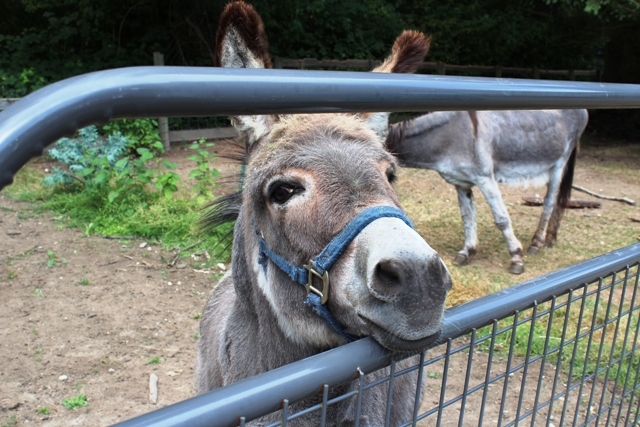You can read part 1 of the Animal Rights Conference Recap from yesterday here. One of the sessions I attended at the conference was on fundraising. I jotted down lots of great tips to understanding fundraising for a nonprofit organization and I thought it might be of interest to some of you who might be thinking about fundraising if I shared them here. The session was led by Alex Hershaft (of Farm Animal Rights Movement) and Carrie LeBlanc (of Mercy for Animals).
Carrie LeBlanc began by talking about the concept of fundraising more generally. She shared how difficult it can be to ask people for money, but urged us all to rethink this encounter with others. Fundraising, she says, is about presenting someone with the opportunity to engage with your organization. Many people have money and want to donate it to a project they believe in—by contacting them, you are giving them the chance to learn about the work your organization is doing and you are inviting them to be a part of that work.
LeBlanc’s initial tips for fundraising are to get set up in an effective way. To launch a fundraising campaign, she recommends working on the following first:
- Create a donor database. There are premade donor database programs you can purchase, if you’ve got some money to spend. But an easy, affordable option is to immediately create a Microsoft Excel spreadsheet. In this spreadsheet, you should record the name, address, email, and phone number of each potential donor. Create a space for notes on that donor (like particular interests, important information, etc.) and also keep track of when and how you contact them.
- Create a logo. Making a logo for your organization is a great way for people to identify you and you can use it on your donation materials.
- Create a clear mission statement. Make sure you have a clear, concise mission statement that tells donors who you are, what you do, and what your specific and more general mission and goals are.
- Create a website. These days it is so important to have an online presence. Creating a website for your organization will help people find you, help them learn about you, and help them donate. Put a ‘donate’ button right up front in a prominent spot.
- Engage with social media. Get your organization on Facebook, Twitter, and other social media sites. These are great free ways to network, get the word out, make donation calls, share information and exciting news, etc.
Once you’ve got a good infrastructure for asking for money, LeBlanc says there are two main methods of fundraising—Passive Methods and Active Methods.
1. Passive Methods. Passive methods are those in which your organization can constantly be engaged. These are methods where you are not explicitly asking an individual for money, but where you are opening the opportunity for them to donate if they want to. Examples of passive methods include:
- DONATE button. Put a donate button on your website or a link to where people can donate on your Facebook page. Write a blog and place a donate button there. This button should link directly to a payment system, like PayPal, where it is easy to donate. These can be added through even fairly simple blog-type websites and are a great way to passively engage.
- Tabling at events. Tabling at events is a great way to get the word out about your organization. Always make sure to have a donations bowl on your table so that people who are inspired to donate can do so easily.
- Newsletters. Newsletters are an awesome way to keep people informed about what’s new with your organization. They are also a chance to passively ask for donations. At the end of each newsletter, include information on how to donate to your organization.
2. Active Methods. Active methods of fundraising are those in which you contact individuals directly and ask for donations. Active methods include:
- Annual fund ask. An annual fund drive happens around the holidays. People are generally in the holiday spirit when these letters arrive and tend to give more during this time of year. If you do no other type of fundraising, you should absolutely do an annual fund ask every year. Usually mailings go out on December 1st and organizations ask for donations to the annual fund. These funds are collected for general use and are unrestricted funds, meaning you can use them for any purpose, including keeping the office running, the lights on (all the un-sexy parts of running an organization). These donation request letters should go out to your entire donor database. TIP: Personalize the envelopes and write handwritten notes on the letters. Making these letters as personal as possible will help you stand out from the pile of other donor letters.
- Major gifts. When you start fundraising, hopefully you will have some major donors start to give to your organization. For each organization, what constitutes a ‘major gift’ will be different—for some $500 is a major donation and for others $10,000 is a major gift. Pay special attention to these donors. Nurture these relationships and don’t be afraid to ask them later on for another donation. Call them personally and let them know how the organization’s latest campaign is doing, invite them to events you might have, or invite them to visit your organization and learn more.
- Events. Events can be an effective way to fund-raise, but they also take a lot of time, effort and money. Generally, you should expect to spend fifty cents for every dollar you make at an event. And yet, events can be a wonderful time to get donors together, to celebrate your organization’s hard work, and introduce new people to the work you are doing. Other ways to have an event include asking one of your major donors to host a small event at their home with 10-50 of their friends. This is a great way to get your major donors more actively involved and it’s an effective way to grow your donor base.
- Membership program. Starting a membership program can be an effective way to get continuous support. You can set up different levels of membership where they will get different things for their membership commitment. These do take a fair amount of work through maintaining the membership program, coming up with incentives to become members, and staying in touch regularly to ensure that members re-up their membership the following year.
- Grants. Applying for grants can be an excellent way to get significant funds for a particular project. You can look at the Foundation Center’s Foundation Directory to see what foundations fund your type of organization. This can often be accessed for free through your local library. Also, looking at who funds other organizations similar to yours is a great way to locate appropriate foundations. LeBlanc recommends seeking out a volunteer grant writer, as writing grants can take a lot of time and expertise. Grants are also fairly restrictive in what they can be used for and they require a fair amount of follow-up in the form of reporting back to the foundation on the outcome of your funded project.
- Planned Giving. LeBlanc suggests having a special page on your website dedicated to planned giving. Planned giving is a way to invite people to include your organization in their will or estate plan. Look at other organizations’ sites who do this to get the proper wording for this so that it is easy for donors to include your organization in these legal documents.
I thought these were some great getting-started tips from Carrie LeBlanc! Alex Hershaft presented second and began by saying, “Now these are all great tips for fundraising. And some of these will cost money to make money. But how do you run an organization when you don’t have any money?” Good question! And Hershaft gave some great down-and-dirty tips for saving money and running an organization effectively. Here are some places where you can save money:
- Rent. Hershaft suggests thinking long and hard about whether you really need to rent an office space. FARM, for instance, is a national organization and runs out of Hershaft’s home. Don’t get caught up in renting a space if it’s not absolutely necessary for your organization.
- Technology. Buying technological equipment and software is a major expense for any organization getting started. Techsoup is an organization that provides technology to nonprofit organizations for a small fee. CNET offers free software downloads.
- Furniture. Large offices do furniture liquidation and will get rid of their furniture for next to nothing. These can be a great way to furnish your office inexpensively.
- Remote Connection. If you are not going to have a brick and mortar office, or you are working with people who are physically distant from you, LogMeIn is a great service that enables remote access and remote collaboration in your organization.
- Printing. Printing can be quite expensive. Hershaft suggests building a relationship with a printer and let them know you are a nonprofit and are looking to save on printing. Planning ahead can save you a lot of money. If you have a printing job that needs to be done in the next couple of months, find out if the printer can give you a discount if they print it whenever they have down-time in their workload. Use the ‘house’ paper at the printer; this is so much cheaper.
- Advertising. Seek out ‘remainder space.’ Many magazines, just before they go to print, will have remainder space (empty space they need to fill). You can often get this ad space for next to nothing.
- Postage. Plan ahead and use media mail for mailings.
- Volunteers. Volunteers are a non-profit’s best friends. Seek out professional volunteers, in particular—people who have professional skills that are useful to your organization, like website design, grant writing, logo design, etc.
I hope these tips from Carrie LeBlanc and Alex Hershaft are useful! What other fundraising tips do you all have?
 Follow
Follow













